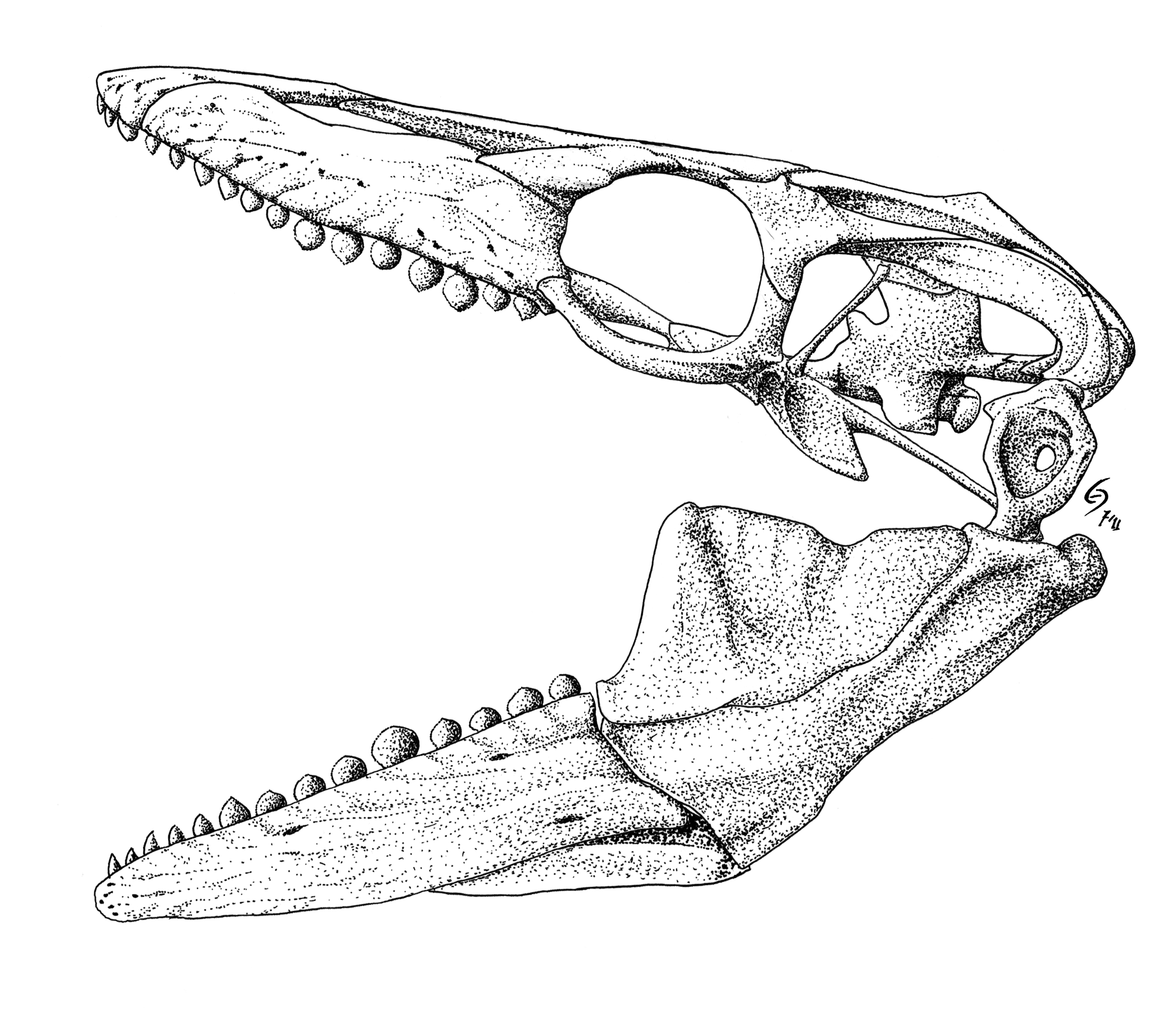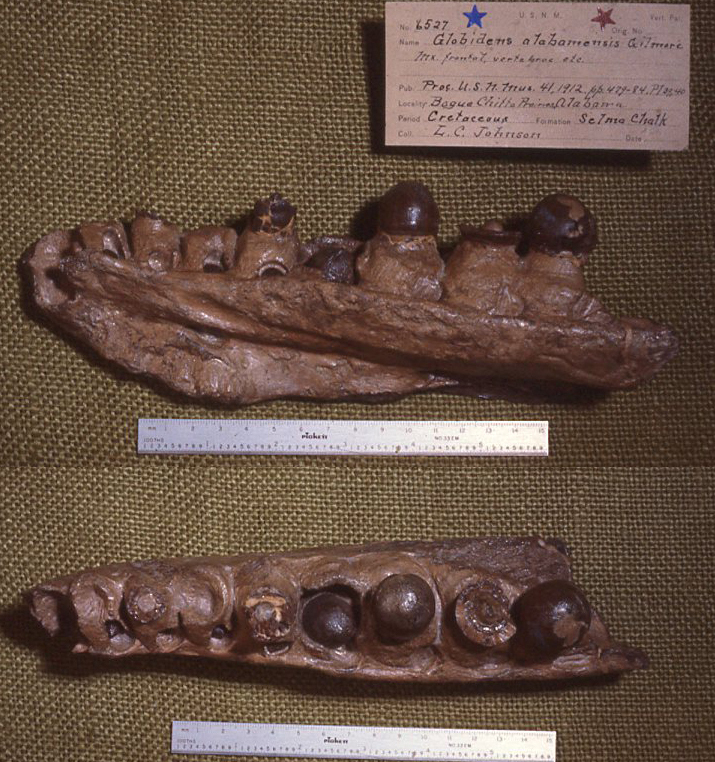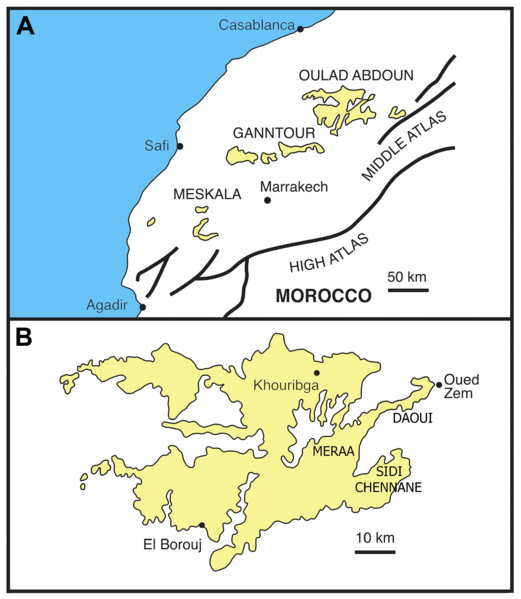|
Igdamanosaurus
''Igdamanosaurus'', meaning "lizard from Igdaman", is an extinct genus of Cretaceous marine lizard belonging to the mosasaur family. It is classified as part of the Globidensini tribe (within the Mosasaurinae), and is like the other members of the tribe recognised by its rounded and knob-like teeth. These teeth indicate a highly specialized lifestyle, likely including a durophagous diet. The genus contains a single species, ''Igdamanosaurus aegyptiacus'', from Maastrichtian-aged marine environments of Africa. Its fragmentary fossil remains have been recovered from the Duwi Formation of Egypt, Ouled Abdoun Basin of Morocco, and the Dukamaje Formation of Niger. Description ''Igdamanosaurus'' was a small durophagous mosasaur at a size roughly similar to the closely related globidensin ''Carinodens.'' Its fossils preserve blunt, rounded teeth similar to those of the other members of the Globidensini. These teeth were better suited for crushing armored prey like molluscs and turtl ... [...More Info...] [...Related Items...] OR: [Wikipedia] [Google] [Baidu] |
Globidensini
The Globidensini or Globidentatini are a tribe of mosasaurine mosasaurs, a diverse group of Late Cretaceous marine squamates. Members of the tribe, known as "globidensins" or "globidensine mosasaurs", have been recovered from North America, Europe, Africa and Asia. The tribe contains the genera ''Globidens'' (the best studied genus by far), '' Carinodens'', '' Igdamanosaurus'',Schulp, Anne S., et al. "New mosasaur material from the Maastrichtian of Angola, with notes on the phylogeny, distribution and palaeoecology of the genus Prognathodon." On Maastricht Mosasaurs. Publicaties van het Natuurhistorisch Genootschap in Limburg 45.1 (2006): 57-67/ref>Lindgren, Johan. "Dental and vertebral morphology of the enigmatic mosasaur Dollosaurus (Reptilia, Mosasauridae) from the lower Campanian (Upper Cretaceous) of southern Sweden." Bulletin of the Geological Society of Denmark 52.17 (2005): e25/ref> '' Harranasaurus'' and '' Xenodens''. Features of the maxilla and digits make the placeme ... [...More Info...] [...Related Items...] OR: [Wikipedia] [Google] [Baidu] |
Globidens
''Globidens'' ("Globe teeth") is an extinct genus of mosasaur lizard classified as part of the Globidensini tribe in the Mosasaurinae subfamily. ''Globidens alabamaensis'' was the first species of ''Globidens'' described, in a publication by Charles W. Gilmore (1912). It is used as the type specimen for ''Globidens''. ''Globidens'' belongs to the family Mosasauridae, which consists of several genera of predatory marine reptiles prevalent during the Late Cretaceous. Specimens of ''Globidens'' have been discovered in Syria, North America, Morocco, Angola, and Indonesia. Among mosasaurs, ''Globidens'' is probably most well known for its highly rounded, globe-like teeth. Description ''Globidens'' was a relatively medium sized mosasaur, measuring long and weighing . It was similar in appearance to other mosasaurs (streamlined body with flippers, a laterally flattened tail and powerful jaws). The teeth of ''Globidens'' differed from those of other mosasaurs in being globu ... [...More Info...] [...Related Items...] OR: [Wikipedia] [Google] [Baidu] |
Ouled Abdoun Basin
The Oulad Abdoun Basin (also known as the Ouled Abdoun Basin or Khouribga Basin) is a phosphate sedimentary basin located in Morocco, near the city of Khouribga. It is the largest in Morocco, comprising 44% of Morocco's phosphate reserves, and at least 26.8 billion tons of phosphate. It is also known as an important site for vertebrate fossils, with deposits ranging from the Late Cretaceous (Cenomanian-Turonian) to the Eocene epoch (Ypresian), a period of about 25 million years. Geography The Oulad Abdoun is located west of the Atlas Mountains, near the city of Khouribga. The Oulad Abdoun phosphate deposits encompass some , an area of . The Oulad Abdoun is the largest and northernmost of Morocco's major phosphate basins, which from northeast to southwest, include the Ganntour, Meskala, and Oued Eddahab (Laayoune-Baa) basins. Paleobiota The Oulad Abdoun Basin stretches from late Cretaceous to the Eocene, and contains abundant marine vertebrate fossils, including sharks, bo ... [...More Info...] [...Related Items...] OR: [Wikipedia] [Google] [Baidu] |
Mosasaurinae
The Mosasaurinae are a subfamily of mosasaurs, a diverse group of Late Cretaceous marine squamates. Members of the subfamily are informally and collectively known as "mosasaurines" and their fossils have been recovered from every continent except for South America. The lineage first appears in the Turonian and thrived until the K-Pg mass extinction at the end of the Maastrichtian. They ranged in size from some of the smallest known mosasaurs (''Carinodens'', 3–3.5 meters), to medium-sized taxa (''Clidastes'', 6+ meters), to the largest of the mosasaurs (''Mosasaurus hoffmannii'') potentially reaching about 13 m in length. Many genera of mosasaurines were either piscivorous or generalists, preying on fish and other marine reptiles, but one lineage, the Globidensini, evolved specialized crushing teeth, adapting to a diet of ammonites and/or marine turtles. Though represented by relatively small forms throughout the Turonian and Santonian, such as ''Clidastes'', the lineage diver ... [...More Info...] [...Related Items...] OR: [Wikipedia] [Google] [Baidu] |
Prognathodon
''Prognathodon'' is an extinct genus of marine lizard belonging to the mosasaur family. It is classified as part of the Mosasaurinae subfamily, alongside genera like ''Mosasaurus'' and ''Clidastes''. ''Prognathodon'' has been recovered from deposits ranging in age from the Campanian to the Maastrichtian in the Middle East, Europe, New Zealand, and North America. ''Prognathodon'' means "forejaw tooth", which originates from the Latin ''pro''- ("earlier" or "prior"), Greek ''gnathos'' ("jaw") and ''odṓn'' ("tooth"). Twelve nominal species of ''Prognathodon'' are recognised, from North America, northern and western Africa, the Middle East, western Europe and New Zealand. Due to the sometimes clear differences between them and the incomplete nature of many of the specimens, the systematics of the genus and which species should properly be considered ''Prognathodon'' is controversial. Some species have been assigned to other genera, such as ''Dollosaurus'' and ''Brachysaurana'', but ... [...More Info...] [...Related Items...] OR: [Wikipedia] [Google] [Baidu] |
Dukamaje Formation
The Dukamaje Formation is a geological formation in Niger whose strata date back to the Late Cretaceous. Dinosaur remains are among the fossils that have been recovered from the formation.Weishampel, David B; et al. (2004). "Dinosaur distribution (Late Cretaceous, Africa)." In: Weishampel, David B.; Dodson, Peter; and Osmólska, Halszka (eds.): The Dinosauria, 2nd, Berkeley: University of California Press. Pp. 604-605. . A wealth of Mosasaur fossils have also been recovered from this formation, particularly from the area around Mt. Igdaman. Fossil content ;Other reptiles * '' Sokotosuchus ianwilsoni'' * '' Palaeophis sp.'' * '' Podocnemis sp.'' * '' Trematochampsa taqueti'' * '' Libycosuchus sp.'' ;Fishes * '' Asteracanthus aegyptiacus'' at |
Late Cretaceous
The Late Cretaceous (100.5–66 Ma) is the younger of two epochs into which the Cretaceous Period is divided in the geologic time scale. Rock strata from this epoch form the Upper Cretaceous Series. The Cretaceous is named after ''creta'', the Latin word for the white limestone known as chalk. The chalk of northern France and the white cliffs of south-eastern England date from the Cretaceous Period. Climate During the Late Cretaceous, the climate was warmer than present, although throughout the period a cooling trend is evident. The tropics became restricted to equatorial regions and northern latitudes experienced markedly more seasonal climatic conditions. Geography Due to plate tectonics, the Americas were gradually moving westward, causing the Atlantic Ocean to expand. The Western Interior Seaway divided North America into eastern and western halves; Appalachia and Laramidia. India maintained a northward course towards Asia. In the Southern Hemisphere, Australia and Ant ... [...More Info...] [...Related Items...] OR: [Wikipedia] [Google] [Baidu] |
Mollusca
Mollusca is the second-largest phylum of invertebrate animals after the Arthropoda, the members of which are known as molluscs or mollusks (). Around 85,000 extant species of molluscs are recognized. The number of fossil species is estimated between 60,000 and 100,000 additional species. The proportion of undescribed species is very high. Many taxa remain poorly studied. Molluscs are the largest marine phylum, comprising about 23% of all the named marine organisms. Numerous molluscs also live in freshwater and terrestrial habitats. They are highly diverse, not just in size and anatomical structure, but also in behaviour and habitat. The phylum is typically divided into 7 or 8 taxonomic classes, of which two are entirely extinct. Cephalopod molluscs, such as squid, cuttlefish, and octopuses, are among the most neurologically advanced of all invertebrates—and either the giant squid or the colossal squid is the largest known invertebrate species. The gastropod ... [...More Info...] [...Related Items...] OR: [Wikipedia] [Google] [Baidu] |
Mosasaurs Of Africa
Mosasaurs (from Latin ''Mosa'' meaning the 'Meuse', and Greek ' meaning 'lizard') comprise a group of extinct, large marine reptiles from the Late Cretaceous. Their first fossil remains were discovered in a limestone quarry at Maastricht on the Meuse in 1764. They belong to the order Squamata, which includes lizards and snakes. Mosasaurs probably evolved from an extinct group of aquatic lizards known as aigialosaurs in the Earliest Late Cretaceous with 42 described genera. During the last 20 million years of the Cretaceous period (Turonian–Maastrichtian ages), with the extinction of the ichthyosaurs and pliosaurs, mosasaurs became the dominant marine predators. They themselves became extinct as a result of the K-Pg event at the end of the Cretaceous period, about 66 million years ago. Description Mosasaurs breathed air, were powerful swimmers, and were well-adapted to living in the warm, shallow inland seas prevalent during the Late Cretaceous period. Mosasaurs were so we ... [...More Info...] [...Related Items...] OR: [Wikipedia] [Google] [Baidu] |
Mosasaurids
Mosasaurs (from Latin ''Mosa'' meaning the 'Meuse', and Greek ' meaning 'lizard') comprise a group of extinct, large marine reptiles from the Late Cretaceous. Their first fossil remains were discovered in a limestone quarry at Maastricht on the Meuse in 1764. They belong to the order Squamata, which includes lizards and snakes. Mosasaurs probably evolved from an extinct group of aquatic lizards known as aigialosaurs in the Earliest Late Cretaceous with 42 described genera. During the last 20 million years of the Cretaceous period (Turonian–Maastrichtian ages), with the extinction of the ichthyosaurs and pliosaurs, mosasaurs became the dominant marine predators. They themselves became extinct as a result of the K-Pg event at the end of the Cretaceous period, about 66 million years ago. Description Mosasaurs breathed air, were powerful swimmers, and were well-adapted to living in the warm, shallow inland seas prevalent during the Late Cretaceous period. Mosasaurs were so we ... [...More Info...] [...Related Items...] OR: [Wikipedia] [Google] [Baidu] |
Elizabeth Nicholls
Elizabeth (Betsy) Laura Nicholls (January 31, 1946 – October 18, 2004) was an American-Canadian paleontology, paleontologist who specialized in Triassic marine reptiles. She was a paleontologist at the Royal Tyrrell Museum in Alberta, Canada. Early life and education Nicholls was born in Oakland, California, and received her undergraduate degree in 1968 from the University of California, Berkeley and her graduate degrees, an M.Sc. in 1972 and a Ph.D. in 1989, from the University of Calgary, working under Samuel Paul Welles. Nichollsemys was also named in her honor. Career She was the co-editor with American vertebrate paleontologist Jack Murff Callaway of the book ''Ancient Marine Reptiles''. ''Latoplatecarpus nichollsae'' was named in her honor. Nicholls was a 2000 Rolex Awards for Enterprise laureate for exploration for her leadership in excavating the remains of a large ichthyosaur, ''Shonisaurus sikanniensis'' (Nicholls & Manabe, 2004), from the Late Triassic, Upper T ... [...More Info...] [...Related Items...] OR: [Wikipedia] [Google] [Baidu] |
Plioplatecarpinae
Plioplatecarpinae is a subfamily of mosasaurs, a diverse group of Late Cretaceous marine squamates. Members of the subfamily are informally and collectively known as "plioplatecarpines" and have been recovered from all continents, though the occurrences in Australia remain questionable. The subfamily includes the genera '' Latoplatecarpus'', ''Platecarpus'', ''Plioplatecarpus'' and '' Plesioplatecarpus''. Plioplatecarpines were small to medium-sized mosasaurs that were comparatively fast and agile compared to mosasaurs of other subfamilies. The first plioplatecarpines appear in the Turonian and are among the oldest of mosasaurs, and the clade persists throughout the Maastrichtian, a period of approximately 24 million years. The subfamily was seemingly heavily affected during a poorly understood middle-Campanian mosasaur extinction event and its genera appear to have faced competition from mosasaurine mosasaurs during the Maastrichtian, leading to a decline in numbers and in diver ... [...More Info...] [...Related Items...] OR: [Wikipedia] [Google] [Baidu] |









